
Бесплатный фрагмент - All sciences. №7, 2022
International Scientific Journal
DEDICATED TO THE HIGHLY RESPECTED SCIENTIST, PROFESSOR TOSHIBOY MIRZAMAKHMUDOVICH MIRZAMAKHMUDOV
UDC 930.85
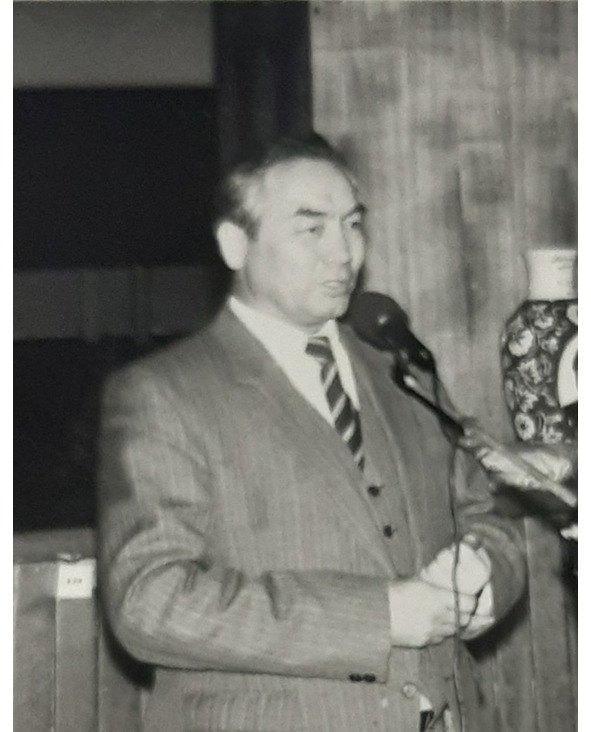
Mirzamakhmudov Tozhiboy Mirzamakhmudovich was born on February 22, 1941 in the village of Nursukh of the Uzbek district of the Fergana region in a working family of collective farmers. From school, the future outstanding scientist actively studied science, conducted a variety of experiments already at that time, showing a tremendous interest in creation and study. And after a while, he was awarded admission to the Fergana Pedagogical Institute Faculty of Physics back in 1957, where he actively continued his activities while still a student. Even then, many scientists-professors and associate professors predicted a great future for him in the field of science. After graduating with honors from the Fergana Pedagogical Institute in 1962, he began his academic career by being hired as a junior researcher at the Fergana State Pedagogical Institute.
In 1964, he entered postgraduate studies at the Physics and Technology Institute of the Academy of Sciences. While studying in graduate school, he continued to work intensively, more and more forming his own scientific ideology, but time inexorably continued to go on, thereby forming a young graduate student, a future scientist. After graduating from graduate school, he began working as a leading engineer at the Physics and Technology Institute of the Academy of Sciences. In graduate school, under the guidance of Academician of the Academy of Sciences of Uzbekistan Adirovich Emanuel Ilyich, who was known for his strictness and exactingness both to himself and to his students, of whom there were not a few, but also Mirzamakhmudovich, as follows from the above, was honored to be named a student of Adirovich, after which he published more than 10 scientific papers.
During the next 6 years, he actively worked on the creation of his first great scientific work on his own idea — a real PhD thesis in the field of studying abnormally high voltages. So in 1970, Tozhiboy Mirzamakhmudovich defended his PhD thesis on the occurrence of abnormally high photo-voltage on cadmium telluride semiconductor films. So in the same year he was hired as a senior lecturer at the Fergana State Pedagogical Institute until 1976. Even then, he actively began training students — future outstanding scientists, among whom were B. H. Karimov, M.A. Karimov, M. M. Ayubzhonov, M.A. Aliyev and others. And in 1976, the Higher Attestation Commission, taking into account his scientific and pedagogical work, awarded him the academic title of associate professor.
According to the memoirs of the students, it can be noted that he was quite demanding of his students, however, like his mentor, but more often expressed kindness and provided mutual assistance. Even then, he sent his students to develop their scientific careers in leading scientific centers, a vivid example of this is Bokhodir Karimov, with whom he personally left for Moscow to the Institute of Crystallography of the Academy of Sciences of the Russian Federation, where he personally introduced Professor Vladimir Mikhailovich Fridkin. And less than 4 years have passed since his student became a candidate of physical and mathematical sciences, like his mentor.
So since 1976 Mirzamakhmudov Tozhiboy Mirzamakhmudovich has been working as an associate professor of the Department of Physics at the Fergana Polytechnic Institute. At that time, he was actively teaching, but also paid great attention to scientific knowledge and research. The result of his desire for science was that he arrived at Vilnius State University. And already 2 years later, that is, since 1978, he was awarded the position of senior researcher at the same Vilnius State University.
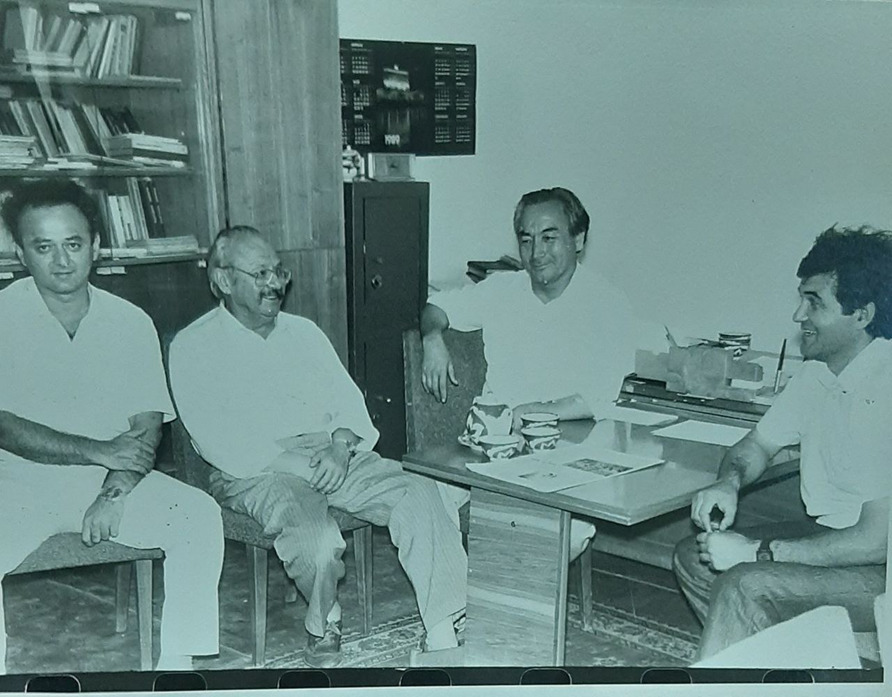
In this scientific center of Vilnius, he actively continued his scientific activities, choosing for himself a very interesting scientific direction. He was interested in the occurrence of abnormally high photovoltage in semiconductor films. For example, on one centimeter of such a semiconductor, it was possible to get as much as 2,000 Volts (!), which was just an amazing result, requiring theoretical justification for itself, as well as a number of proofs.
His works did not remain without a trace and already in 1979, Tozhiboy Mirzamakhmudovich defended his doctoral dissertation at the same Vilnius State University on this burning topic: “The occurrence of abnormally high photovoltage in semiconductor films and new principles for the creation of optoelectronic devices.” It is worth noting that in the subject of the dissertation, not only the justification of the phenomenon itself is derived, but also its practical application for the creation of optoelectronic devices that increase their efficiency is proposed.
But as time went on, the love for the Motherland became stronger and stronger, increasing the desire to once again contemplate such dear lands of Uzbekistan, their relatives, two sons and a daughter, as well as the Fergana Polytechnic Institute (FerPI), which has already become almost native. That is why he returned to Uzbekistan in 1980 to FerPI and since that time his activities have been closely connected with the Polytechnic Institute. There he begins to head the Faculty of Energy.
At the time of 1982, he, being at the very dawn of his strength, at the age of 41, saw the next fruits of his labors — the higher attestation commission awarded the academic title of professor to Also Mirzamakhmudovich. From 1984 to 1987, Tozhiboy Mirzamakhmudovich took the honorary post of vice-rector of the evening correspondence department of the Fergana Polytechnic Institute, actively continuing his scientific activities, but the craving for knowledge, the thirst for creation continued to torment him, which is why from 1987 to 1991 he assumed the post of vice-rector for Research, where he was able to plunge again into the amazing world of science and creation.
Mirzamakhmudov was widely known and recognized for his work in the field of research of photoresistive and photoelectric phenomena in semiconductor film elements. To put it more simply, these film elements transmitted energy when illuminated, but in its absence they did not immediately lose it, but reduced the amount of transmitted current very evenly, up to a certain amount, which they stored like a memory element!
In this field, Mirzamakhmudov and a group of his students conducted a series of studies on the development and study of photo-portrait elements, those very memory cells that arise due to the internal field of p-n transitions. For the first time in the world, photoelectric elements from triple semiconductor compounds were discovered, that is, if single or binary compounds were previously used and their properties were already studied, then triple compounds were discovered here for the first time, surprisingly their properties were much more complex than binary, not to mention single cases. And in 1988, under the leadership of Mirzamakhmudov, a new effect was first revealed — an abnormally high photoelectromagnetic voltage without an external field in two film semiconductor materials, which meant that not only when an electric current passed through the crystals, but also through the film, the Hall effect was observed — a deviation of electron flows in a magnetic field, along with the fact that the current flowed and straight, deviating a little, so even in the film it was possible to separate the charge.
During his long scientific career, which lasted more than 50 years, Mirzamakhmudov published more than 100 scientific papers, two monographs received more than 10 author’s certificates. He is the author of several methodological manuals and the editor of textbooks on theoretical physics. Some of his works have been published in Bulgaria, Czechoslovakia and Japan. At the initiative of Tozhiboy Mirzamakhmudovich, many scientific laboratories studying the most pressing issues and problems of modern science of that time were opened at the Fergana Polytechnic Institute, a postgraduate school and small commercial enterprises were established, and a research laboratory for the study of the physicochemical properties of semiconductor solar cells was established under his direct supervision.
Tozhiboy Mirzamakhmudovich devoted a lot of effort and energy to establishing scientific contacts with leading centers and universities of the country. Mirzamakhmudov had the ability to see a future scientist in a student and a young specialist, to direct his activities in the direction of scientific research. More than twenty PhD theses have been defended under his leadership.
The results of the research of the Institute’s employees who worked under the leadership of Mirzamakhmudov are widely implemented today in the field of physics, mathematics, chemistry and other sciences. And many of his scientific works continue to be published posthumously, honoring his memory, a vivid example of this is the textbook “Electronics Asoslari” published in 2022, co-authored by his student B. Karimov.
The great scientist continued his work, leaving behind a great legacy not only in the face of his numerous works, but also not small students who are now candidates, doctors of sciences, professors, and some have already gone with their teacher to another world.
Tozhiboy Mirzamakhmudovich himself left our world on November 9, 2009, leaving behind the great memory of the great scientist…
Nilufar Tajibayevna Mirzamakhmudova
Senior Lecturer of the Department of “Higher Mathematics” of the Faculty of Mechanics and Mechanical Engineering of the Fergana Polytechnic Institute
Bokhodir Hashimovich Karimov
Candidate of Physical and Mathematical Sciences, Associate Professor of the Faculty of Physics and Technology of Fergana State University
PHYSICAL SCIENCES
THE USE OF NEW NANOSTRUCTURE METHODS ALLOWING TO INCREASE THE MONOCHROMATICITY OF THE BEAM DURING ACCELERATION
UDC 621
Rinat Fuadovich Rumi
Senior Researcher, Head of the Laboratory of Accelerator Technology at the Research Institute “Physics of Semiconductors and Microelectronics” at the National University of Uzbekistan
Laboratory of Accelerator Technology at the Research Institute “Physics of Semiconductors and Microelectronics” at the National University of Uzbekistan, Tashkent, Uzbekistan
Abstact. The development of accelerator technology has been actively observed after numerous works by Ernest Rutherford, from the discovery of the planetary model and the implementation of the first nuclear reaction to the present day. And it is worth noting that for each time there were quite interesting requirements for charged particle beams, among which the most popular requirement at almost all times was the beam energy, then its current can be noted, but one of the most important among them is the monochromaticity of the charged particle beam.
Keywords: monochromaticity, monoenergetics, charged particle beam, accelerator, nanostructures.
Аннотация. Развитие ускорительной техники наблюдалось активно после многочисленных работ Эрнеста Резерфорда, от открытия планетарной модели и осуществления первой ядерной реакции до сегодняшний дней. И стоит отметить, что для каждого времени существовали довольно интересные требования к пучкам заряженных частиц, среди коих самым популярным требованием почти во все времена являлась энергия пучка, затем можно отметить его ток, но одним из важных среди них является монохромотичность пучка заряженных частиц.
Ключевые слова: монохроматичность, моноэнергетичность, пучок заряженных частиц, ускоритель, наноструктуры.
Introduction
Initially, it is necessary to give a general concept of the monochromaticity parameter itself, which is often associated with monoenergetics. The whole point is that the beam, after its formation by thermionic, auto- or other emission, has a heterogeneity in energy, which is why the particles in its various regions have different, albeit slightly distinguishable energies. With acceleration, their given spread or gradient increases, although it becomes smoother. For example, on accelerators of the 80s, an example of which is the SOKOL-2 accelerator, monoenergetics of up to 5 keV is achieved at 2 MeV of the total beam energy, while on modern accelerators, at an energy of 20 MeV, an accuracy of up to 1 keV is achieved in maximum accuracy.
Problems
If the question arises about the figure of this value, then it is thanks to it that we can talk about the effectiveness of the entire reaction, because as far as the energies in the beam are homogeneous and have a value close to each other, so much more of them will be close to the energy desired for this reaction channel — to the necessary resonance, which will make the reaction more efficient.
Today, exo-energetic nuclear reactions are known, the output particles in which have more energy than at the input, but at the same time such a reaction takes place only for a part of the particles due to the very smallness of the total monoenergetics of the beam.
Solving the problem
To achieve results, that is, to increase the efficiency of the conducted nuclear reaction, it is necessary to increase monoenergetics, and for this it is necessary to develop a method for equalizing energy on different parts of the beam. As is known, in a magnetic field, under the influence of the Lorentz force (1—2), particles are deflected, while the beam at the maximum energy in its center and decreasing closer to the edges is stratified, passing into a kind of energy gradient.


Further, it is more likely that the beam will be divided into component parts, where the losses will be much less than it would be with “beam selection” with losses of more than 90%, namely, for divisions, the losses will be only 12%. Nanotubes, in themselves, are formations resembling carbon tubes that transmit a charge, but at the same time separated from each other by a dielectric layer of molecules.
For the formation of a charge in such a system, a vertical and horizontal transmission line is carried out to each tube, with the closure of which this particular cell is charged. When a second system of the same type is located opposite, a potential difference arises between them, thanks to which it is possible to give energy in the gradient spectrum, the reverse of the incoming beam gradient, while losing only 12% of the total number of charges, and, accordingly, current.
At the same time, it is important to note that although it is not so difficult to vary the potential differences within the framework of a modern 1 keV accelerator, but the accuracy is not infinite. While maintaining the same voltage ratio for 20 MeV, an accuracy of up to 0.04—0.05 eV can be achieved, which is a shocking result.
But this technology is currently being developed in a theoretical matter and is not without disadvantages, for example, such a system is suitable for fairly small beams with currents of 1 nA and only in very rare cases up to 1 µA, but it is possible to find a solution with the creation of sets of such small beams divisible in the future, but this stage is the beginning a new study that further increases the efficiency of accelerator technology and possibly, with the implementation of this technology on the charged particle accelerator of the Electron project, it will become possible to name this accelerator having the highest monoenergetics of the beam, and, accordingly, the highest efficiency of all nuclear reactions carried out on it.
Used literature
1. Karimov B. H. Elektronika asoslari. Study guide. — [B.M.]: Scientific school “Electron”, Publishing solutions. Ridero, 2022. — 176 p
.2. Aliyev I. H., Karimov B. H. Course of physics of charged particle accelerators. Study guide. — [B.M.]: Scientific school “Electron”, Publishing solutions. Ridero, 2022. — 203 p.
3. Aliyev I. H., Karimov B. H., Karimov Sh. B., Yuldoshaliev D. K. Industrial and alternative aerators based on green energy for fish reservoirs. Monograph. — [B.M.]: Scientific school “Electron”, Publishing solutions. Ridero, 2022. — 221 p.
4. Aliyev I. H., Burnashev M.A. Ingential mathematics. Monograph. — [B.M.]: Scientific school “Electron”, Publishing solutions. Ridero, 2022. — 149 p.
5. Aliyev I. H., Karimov B. H., Karimov Sh. B., Yuldoshaliev D. K. Development of aerator technology based on alternative energy sources. The Electron project. Monograph. — [B.M.]: Scientific school “Electron”, Publishing solutions. Ridero, 2022. — 141 p.
6. Aliyev I. H. Software modeling of nuclear reaction phenomena based on the technology of creating a set of data using a system of algorithms in C++. The Core-COMPUTER project. Monograph. — [B.M.]: Scientific school “Electron”, Publishing solutions. Ridero, 2022. — 156 p.
7. Karimov B. H., Mirzamakhmudov T. M. Electronics asoslari. Study guide. — [B.M.]: Scientific school “Electron”, Publishing solutions. Ridero, 2022. — 184 p.
8. Aliev I. H. New parameters for nuclear reactions to be carried out on an accelerator of charged particles of the LCU-EPD-300 type. The Electron project. Monograph. — [B.M.]: Scientific school “Electron”, Publishing solutions. Ridero, 2022. — 498 p
.9. Aliyev I. H. Software modeling of nuclear reaction phenomena based on technologies for creating a set of data using a system of algorithms in C++. The Core-COMPUTER project. Monograph. — [B.M.]: Scientific school “Electron”, Publishing solutions. Ridero, 2022. — 498 p.
10. Aliev I. H., Sharofutdinov F. M. The use of accelerators and the phenomena of collisions of elementary particles with high-order energy to generate electrical energy. The Electron project. Monograph. — [B.M.]: Scientific school “Electron”, Publishing solutions. Ridero, 2021. — 594 p.
11. Otazhonov S. M., Alimov N. E. Photoelectric phenomena in wide-band semiconductor heterostructures with deep impurity levels. Monograph. — [B.M.]: Scientific school “Electron”, Publishing solutions. Ridero, 2022. — 112 p.
12. Otazhonov S. M. “Mavzu ishlanmasi” tayyorlashning innovatsion xarakterga ega bo’lgan metodi. Monograph. — [B.M.]: Scientific school “Electron”, Publishing solutions. Ridero, 2022. — 158 p.
13. Karimov Sh. B., Karimov B. H., Aliyev I. H. Spatially oscillating photovoltaic current in an optically active SbSl ferroelectric. All sciences. — №6. Electron Scientific School, Publishing solutions. Ridero, 2022. — pp. 33–50.
14. Zhalolov B. R., Karimov B. H., Aliyev I. H. The role of resonant nuclear reactions in modern energy. The role of resonant nuclear reactions in modern energy. All sciences. — №6. Electron Scientific School, Publishing solutions. Ridero, 2022. — pp. 50–113 p.
15. Aliyev I. H. Prospects for the use of neutron energy. All sciences. — №6. Electron Scientific School, Publishing solutions. Ridero, 2022. — pp. 122–133.
16. Zhalolov B. R. Investigation of solar physics in the study of the solar energy industry. All sciences. — №5. Electron Scientific School, Publishing solutions. Ridero, 2022. — pp. 11–29.
17. Aliyev I. H. On a heuristic idea about the emergence of a new energy technology for obtaining energy from resonant nuclear reactions. All sciences. — №1. Electron Scientific School, Publishing solutions. Ridero, 2022. — pp. 13–18.
18. Karimov B. H. A general idea of the LCC-EPD-20 accelerator. All sciences. — №1. Electron Scientific School, Publishing solutions. Ridero, 2022. — pp. 18–23.
19. Zhalolov B. R. Implementation and scientific publications on the Electron project. All sciences. — №1. Electron Scientific School, Publishing solutions. Ridero, 2022. — pp. 23–28.
20. Sharofutdinov F. M. Statement of facts about the stages of development of the Electron project and the brightest hopes for the future. All sciences. — №1. Electron Scientific School, Publishing solutions. Ridero, 2022. — pp. 28–33.
21. Aliev I. H. Aluminum resonance reaction. All sciences. — №3. Electron Scientific School, Publishing solutions. Ridero, 2022. — pp. 24–44.
22. Sharofutdinov F. M. On the introduction of a new nuclear energy unit from the point of view of economics and diplomacy. All sciences. — №6. Electron Scientific School, Publishing solutions. Ridero, 2022. — pp. 347–361.
23. Aliyev I. H., Umarova G. M. The use of innovative technologies in teaching. Humanitarian treatise — No. 78. Publishing house “Pluto”. 2020 — pp. 17–18.
24. Aliyev I. H., Karimova M. I. The role of the philosophical meaning of the work in teaching in schools. Humanitarian treatise — No. 79. Publishing house “Pluto”. 2020 — pp. 36–38.
25. Aliyev I. H., Nishonova D. O. Nikola Tesla Tower. A humanitarian treatise. — №92. Publishing house “Pluto”. 2020. — pp. 9–13.
26. Aliyev I. H., Karimova M. I., Kharipova S. B. A new step method. A humanitarian treatise. — №92. Publishing house “Pluto”. 2020. — pp. 14–17.
27. Aliyev I. H., Karimov B. H. On a heuristic idea regarding the algorithmization of the functioning of the human brain based on the theories of electromagnetic fields of biological streams and their active interaction with other objects and dimensions. Oliy va o’rta maxsus ta’lim vazirligi huzuridagi “Oliy ta’limni rivojlantirish tadqiqotlari va ilg’or texnologiyalarini tatbiq etish markazi” “Ilm, ma’rifat va raqamli iqtisodiyotni rivojlantirish istiqbollari” Onlayn Respublika ilmiy-amaliy anjuman maruzalar to’plami. Tashkent. 2020. — pp. 164–178.
28. Aliev I. H. Collision energy of oncoming beams. A young scientist. International Scientific Journal. — №16 (306). Publishing house “Young Scientist”. 2020. — pp. 7–10.
29. Aliyev I. H., Karimov B. H., Karimov Sh. B., Yuldoshaliev D. K., Aliyev M. I. Alternative wind aerator for fish reservoirs. A young scientist. International Scientific Journal. — №49 (287). Publishing house “Young Scientist”. 2019. — pp. 173–175.
30. Aliyev I. H., Toshtemirov M. H., Karimov B. H. A device for using solar energy to increase temperature with a hydrodynamic mechanism in a common design, which is a solar collector. A young scientist. International Scientific Journal. — №18 (360). Publishing house “Young Scientist”. 2021. — pp. 117–120.
31. Aliyev I. H., Karimov B. H. Linear electron accelerator in power engineering. Exact science. — №85. Publishing house “Pluto”. 2020. — pp. 23–29.
32. Aliyev I. H. The behavior of an electron in an atom. Exact science. — №63. Publishing house “Pluto”. 2019. — pp. 37–39.
33. Aliyev I. H. Electron and its features. Exact science. — №71. Publishing house “Pluto”. 2020. — pp. 2–5.
34. Aliyev I. H. Entangled micro-friends. “Uyda qoling!” shiori ostida “Oliy ta’lim islohorlari: yuruqlar, muammolar, yechimlar” mavzusidagi respublika miqyusida onlayn ilmiy maqolalar hamda innovatsion ixtirolar tanlovining ilmiy maqolalar to’plami. Tashkent. 2020. — pp. 164–178.
35. Aliyev I. H., Karimov B. H., Mirzazhonov Z., Karimov N. I. Autonomous aerator for fish reservoirs. Ministry of Higher and Secondary Special Education of the Republic of Uzbekistan. Academy of Sciences of the Republic of Uzbekistan. Ministry of Innovative Development of the Republic of Uzbekistan. Fergana Polytechnic Institute. Proceedings of the V International and Conference on Optical and Photoelectric Phenomena in Semiconductor Micro- and Nanostructures. Part II. Ferghana. 2020. — pp. 147—149.
MATHEMATICAL SCIENCES
DIRECT APPLICATION OF IMPLICATION AND EQUIVALENCE
UDC 519.9
Nematov Islom
Candidate of Physical and Mathematical Sciences, Associate Professor of the Department of “Mathematics” of the Faculty of Mathematics and Computer Science of Fergana State University
Aliev Ibratjon Xatamovich
2nd year student of the Faculty of Mathematics and Computer Science of Fergana State University
Ferghana State University, Uzbekistan
Annotation. Discrete mathematics, which is increasingly gaining popularity, has also been able to find its own application thanks to the introduction of new information sciences using the binary number system, both in the face of classical and quantum computer science. In this paper, the question of finding not only the indirect, but also the direct direct application of implication and equivalence operations known since the 60s of the XX century, the search for which has continued to the present time, is considered.
Keywords: discrete mathematics, implication, equivalence, direct application, practical application, technical understanding, electrical circuit.
Аннотация. Дискретная математика всё больше получающая популярность также смогла найти и собственное применение благодаря введению новых информационных наук с использованием двоичной системы счисления, как в лице классической, так и квантовой информатики. В данной работе рассмотрен вопрос относительно нахождения не только известного ещё с 60-х годов XX века косвенного, но и непосредственного прямого применения операций импликации и эквиваленции, поиск коих продолжался до настоящего времени.
Ключевые слова: дискретная математика, импликация, эквиваленция, прямое применение, практическое применение, техническое осмысление, электрическая схема.
At the moment, a variety of operations are actively used in discrete mathematics and logic to describe the conduct of actions on judgments. So the main operations are conjunction, disjunction and negation, so known as logical multiplication, logical addition and logical negation, respectively. They allowed us to operate on various judgments that accept the result either “true” — 1 or “false” — 0.
Each of the operations at the same time had its own truth table. For conjunction it is (Table 1), for disjunction — (Table 2) and logical negation — (Table 3).

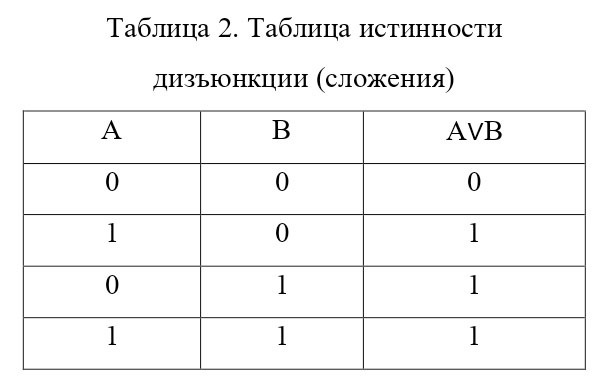
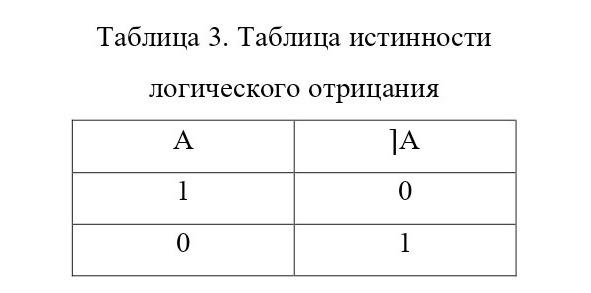
At the same time, for the conjunction (logical “And”), a serial connection scheme takes place in the practical description (Fig. 1), described in the following cases:
1. If there is no current through “A” and through “B”, as a result there is no current;
2. If there is a current in “A”, but in the absence through “B”, as a result there is no current;
3. If there is no current in “A”, but in the presence of “B”, as a result there is no current;
4. If there is a current in “A” and in the presence of “B”, as a result, there is a current.
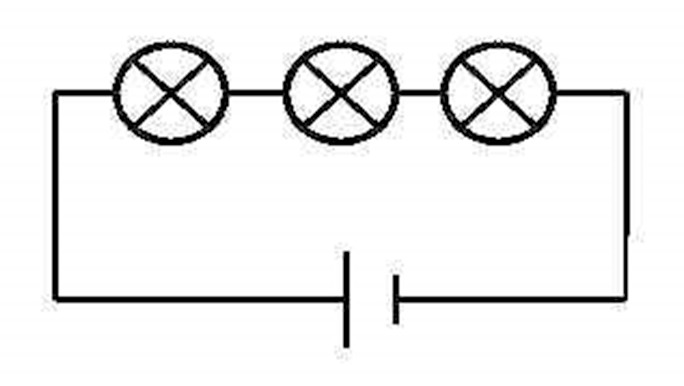
For a disjunction (logical “OR”), a similar representation can be seen in the face of a parallel connection (Fig. 2), described already in the following cases:
1. If there is no current through “A” and through “B”, as a result there is no current;
2. If there is a current in “A”, but in the absence of through “B”, as a result, there is a current;
3. If there is no current in “A”, but in the presence of “B”, as a result, there is a current;
4. If there is a current in “A” and in the presence of “B”, as a result, there is a current.
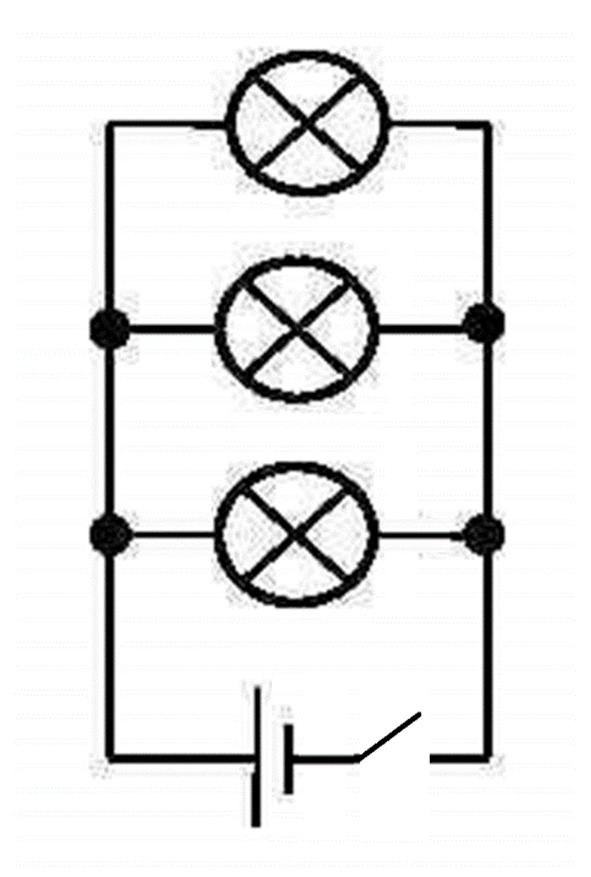
For logical negation (logical “NOT”), everything is even simpler, because it can be represented as an ordinary reverse button (Fig. 3), describing the actions as follows:
1. If there is a current in “A”, as a result there is no current;
2. If there is no current in “A”, as a result, there is a current.

But along with these operations, there were also implication and equivalence operations, where implication is a logical consequence or statement “Follows from here”, and equivalence is logical equivalence and or the statement “Then and only then” had the following truth table (Table 4), and equivalence — (Table 5).
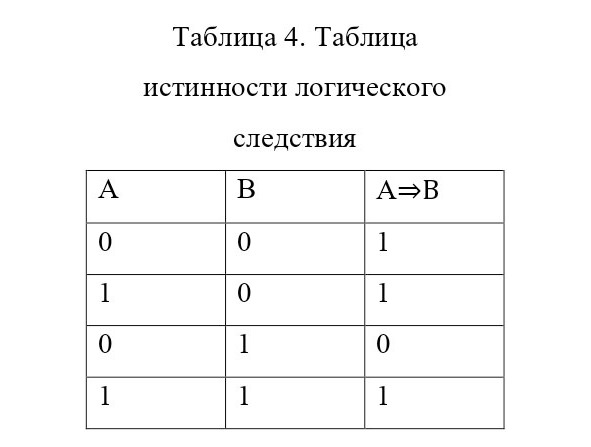
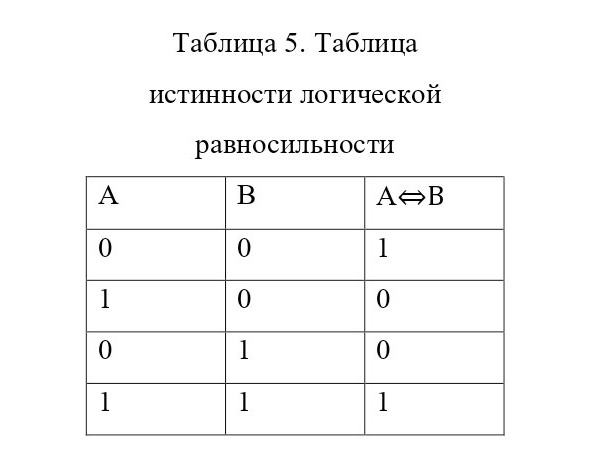
At the same time, both operations have not yet been applied in practice in direct form, as it looked for conjunction and disjunction. To date, the transformation is used for implication (1) and for equivalence (2).

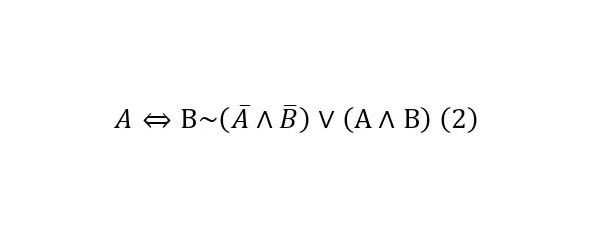
That is, the implication can be represented as a negation of the first and a disjunction with the second statement, and the equivalence as a conjunction of the negations of both judgments on the disjunction of the conjunction of both judgments. If we check the truth of (1) and (2) on the table, then the result will be valid (Table 6—7).
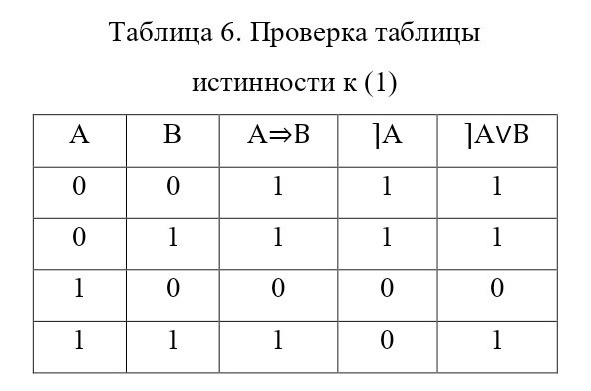
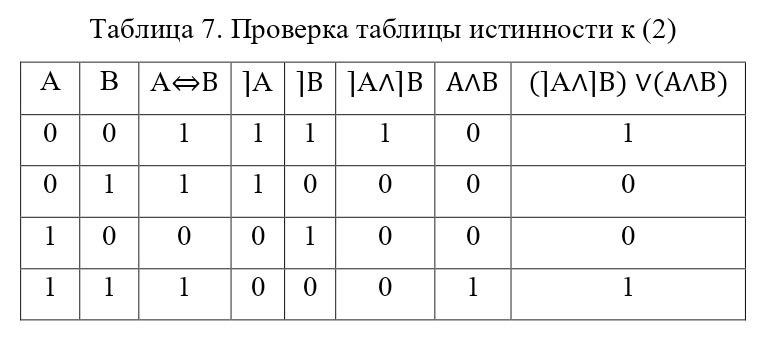
And the methods presented were considered the only possible ones to this day, until finally an electric element was created, a kind of connection in which implication and equivalence would be performed in the direct case.
The first device, the implicator, consists of a vacuum flask 7 with a cathode 3 and an anode 1, between which an anode grid 2 is placed. The distance between the cathode and the anode l is verified with the accuracy that it is less than or equal to the free path of electrons that have flown from the cathode to the anode. There is also an isolated electrode 6, connected from the outside (behind the bulb) to the cathode pin 3, but not connected to it (Fig. 4).
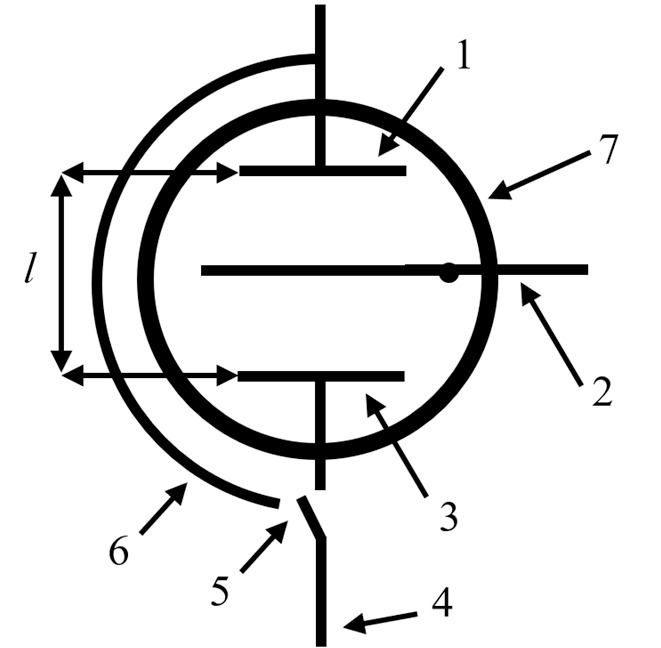
Thus, let the anode grid 2 act as the second statement, the cathode 3 as the first, and the anode 1 as the result. At the same time, a condition is introduced that before the current 4 arrives at the cathode 3, a divider 5 is supplied, which reacts to the magnitude of the incoming current, if the current is greater than or equal to a certain value taken as the truth of the first judgment, then it is connected to the cathode 3, otherwise to the electrode 6 coming out of the anode. In this case, the exception is the case when there is a current on the anode grid 2, while it is assumed that the current does not go to the cathode and to the cathode circuit at all.
So, in this scheme, we can consider four situations:
1. If there is no current at the cathode and there is no current on the anode grid, then the current flows through the electrode to the anode, as a result there is a current;
2. If there is current at the cathode, but there is no current on the anode grid, then the electrons reach the anode, as a result there is current;
3. If there is no current at the cathode, but there is no current on the anode grid, there are also no electrons in the bulb, which is why there is no current as a result;
4. If there is current at the cathode and there is current on the anode grid, then the electrons receive additional acceleration, which means that there is also current as a result.
This device, as you can see, although with a couple of conventions, which can be completely replaced by reducing elements, a kind of sensors or switches, fully performs the function of implication. But it is also interesting to mention here that neither conjunction nor disjunction was used, nor even negation, unless of course the “switch” is considered an extremely distant relative of negation, which would be inappropriate. Moreover, this system acts as a single element that fully fulfills the task.
Speaking of this type of connection, it should be called a “close mixed” connection, or a “Promichtovoe” connection, from the Latin prore — “close” and mixta — “mixed”, since both parallel and serial connection are involved here, but more figuratively, because of which this connection acts new — the third kind.
The situation with equivalence is similar, but the difference is that the distance between the cathode 3 and the anode 1 — L (for the equivalentor) must be strictly greater than the electron path length so that they cannot reach it without the help of an anode grid, which, however, explains why the implicator is connected “close-mixed” connection. When using the same equivalentor (Fig. 5) — a device that performs the function of equivalence, there are also 4 cases:
1. If there is no current at the cathode and there is no current on the anode grid, then the current flows through the electrode to the anode, as a result there is a current;
2. If there is current at the cathode, but there is no current on the anode grid, then the electrons do not reach the anode, as a result there is no current;
3. If there is no current at the cathode, but there is no current on the anode grid, there are also no electrons in the bulb, which is why there is no current as a result;
4. If there is a current at the cathode and there is a current on the anode grid, then the electrons receive additional acceleration, which means that there is a current as a result.
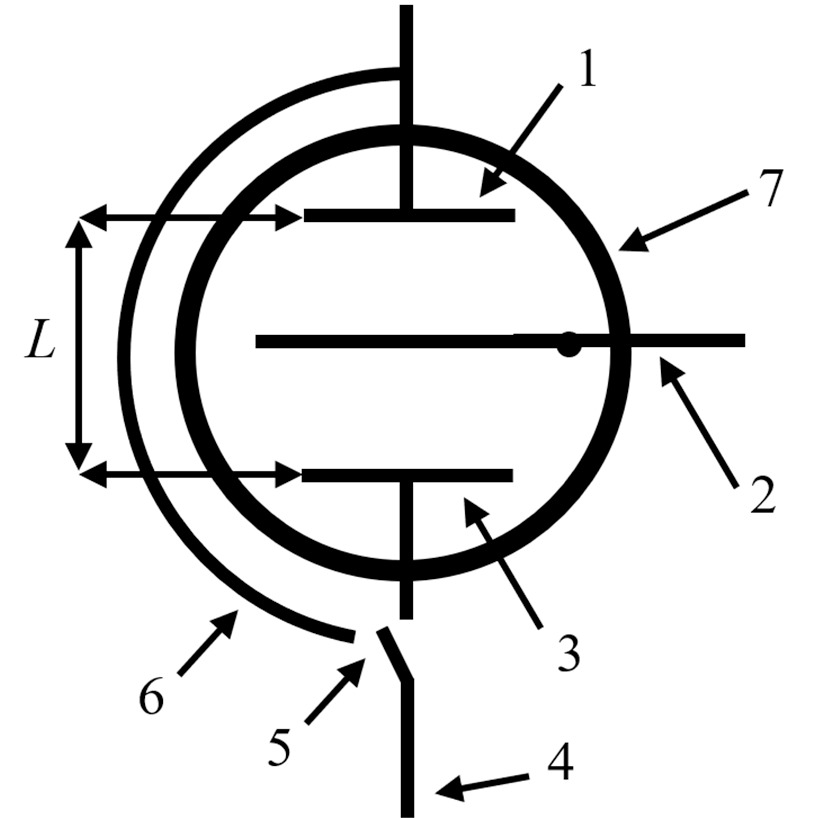
The equivalentor is similarly connected by the type of connection in this case by a “far-mixed” or “Longmichth” connection, from the Latin longe — “far away” and mixta — “mixed”.
Thus, it is possible to demonstrate two elements — an implicator and an equivalentor that fully perform the functions of implication and equivalence in modern electronics, finding perfect application, allowing to reduce space at times, because these circuits can be made in an arbitrarily small size, along with replacing the “diode-lamp” part with the presence of vacuum with modern triodes with the usual additional switchable connection for the implicator and more upgraded triodes with the same switches and connection for the equivalentator.
Presenting this scheme, we can hope that it will bring its benefits, contributing to the development of modern science and technology, improving and bringing new things to science, as well as opening up new even more grandiose horizons to the entire human civilization!
Used literature
1. Mendelson E. “Introduction to mathematical logic”. — M. Nauka, 1971.
2. Edelman S. L. Mathematical logic. — M.: Higher School, 1975. — 176 p.
3. Igoshin V. I. Taskbook-practical course in mathematical logic. — M.: Enlightenment, 1986. — 158 p.
4. Gindikin S. G. Algebra of logic in problems. — M.: Nauka, 1972. — 288 p
.5. Barabanov O. O. Implication / Proceedings of the XI International Kolmogorov readings: collection of articles. — Yaroslavl: YAGPU Publishing House, 2013. pp.49—53.
INFORMATION TECHNOLOGY
A WAY TO PROTECT INFORMATION FROM UNAUTHORIZED ACCESS TO THE VOLS
UDC 004.056
Kuldashov Obozjon Khakimovich
Doctor of Technical Sciences, Professor of the Scientific Research Institute “Physics of Semiconductors and Microelectronics” at the National University of Uzbekistan
Komilov Abdullazhon Odiljon ugli
Assistant of the Fergana branch of the Tashkent University of Information Technologies named after Muhammad al-Khorezmi
Ferghana branch of Tashkent University of Information Technologies named after Muhammad al-Khorezmi
Annotation. The article proposes a method for protecting an information signal from unauthorized access in a fiber-optic communication line, provides a block diagram and the principle of operation of the device.
Keywords: fiber-optic line, communication, information signal, protection method, device, block diagram.
Аннотация. В статье предложен способ защиты информационного сигнала от несанкционированного доступа в волоконно-оптической линии связи, приведена блок схема и принцип работы устройства.
Ключевые слова: волоконно-оптическая линия, связь, информационный сигнал, способ защиты, устройство, блок схема.
In recent years, one of the most promising and developing areas of building a communication network in the world is the VOLS.
The priority direction of the development of the transport network of Uzbekistan is the transfer of the network to the widespread use of fiber optic networks with digital transmission systems.
This made it possible to organize reliable high-quality communication not only between the “telephone continents”, but also communication on the National Telecommunications Network of Uzbekistan. The realization of this task has become possible since 1997 after the completion of the construction and commissioning of the national segment of TAE — a large-scale international project “Trans-Asian-European VOLS”.
In 2011, the task was to ensure the development and modernization of the telecommunications network based on the introduction of modern broadband and optical technologies, the introduction of over 950 kilometers of fiber optic lines, the expansion of the data transmission transport network to regional centers.
Throughout the country, at the level of district centers, obsolete analog telephone exchanges have been replaced with modern digital ones. High-speed digital channels have been created on the basis of the VOLS, work is underway to expand the network and improve its reliability. The created infrastructure serves as the basis for the rapid development of wireless technologies, in particular, mobile communications. As a result, the level of coverage by the digital telecommunications network of regions, district centers and cities of the Republic amounted to 100 percent, the level of coverage by the telecommunications network of rural settlements — 95.7 percent.
In 1999–2000, at the expense of the funds of the Cooperation Fund for Economic Development of the Republic of Korea (EDCF), technical re-equipment and development of the telecommunications network in the Andijan and Ferghana regions were carried out, a 354 km long fiber-optic line was built, switching equipment with a capacity of 46 thousand numbers was installed.
The widespread use of fiber-optic telecommunication systems in communication networks is due to a number of their advantages in comparison with electrically cable communication systems.
Based on this, the following main advantages of a fiber-optic line can be distinguished in comparison with electric cable communication systems:
— huge bandwidth with transmission speeds of up to 40 Gbit/s, operating today, and over 100 Gbit/s, expected in the near future. The factors limiting the growth of transmission rates are currently the inertial properties of receivers and radiation sources. However, the use of the spectral compaction method (WDM, wave division multiplexing) increases the total transmission rate over a single fiber to several Departures/s;
— fiber optic cables are completely unaffected by electromagnetic interference, lightning and high voltage surges. They do not create any electromagnetic or radio frequency interference;
— ensuring complete galvanic isolation between the receiver and the information transmitter, as well as the absence of a short circuit in the transmission line;
— the distance of information transmission for low-cost fiber-optic cables between repeaters is up to 5 km. For high-quality commercial systems, the distance between repeaters is up to 300 km. Distances close to 1000 km have been achieved under laboratory conditions;
— the size and weight of fiber optic cables compared to all other data cables are very small in diameter and extremely light. A four-core fiber optic cable weighs approximately 240 kg/km, and a 36-core fiber optic cable weighs only 3 kg more.
From the above it follows that the VOLS meet all the requirements of modern telecommunication communication systems. In this regard, many experts in telecommunications technologies argue that the VOLS will become the main means of transmitting information in the future. However, with the growth of the use of fiber-optic information transmission lines in telecommunication systems and their development, technical information intelligence systems are also developing, with the help of which information is secretly taken from the VOLS.
All over the world, great attention is paid to ensuring information security — the state of security of the information environment of society, ensuring its formation, use and development in the interests of citizens, organizations, and the state.
Therefore, the development of effective methods and technical means for the protection of information in the VOLS is one of the urgent tasks.
Structural, mechanical and electrical technical means are usually used to protect information in the VOLS. Some of the types of protective equipment of this group are built in such a way as to complicate the mechanical cutting of the cable and prevent access to the S [1]. Similar means of protection are widely used in traditional wired networks of special communication. Also promising is the use of a pair of longitudinal power elements of the OK, which are two steel wires arranged symmetrically in a polyethylene shell, and used for remote power supply and monitoring of sensors installed in the couplings, and monitoring of ND. It is also advisable to use a kit to protect the welding site, which fills the welding site with an opaque solidifying gel. One of the proposed methods of protection is the use of multilayer optical fiber with a special structure of reflective and protective shells [2]. The construction of such a fiber is a multilayer structure with a single-mode core. The selected ratio of the refractive coefficients of the layers makes it possible to transmit a multimode control noise optical signal along the annular guide layer. There is no connection between the control and information optical signals in the normal state. Ring protection also makes it possible to reduce the level of radiation of an information optical signal through the side surface of the S (by means of leakage modes arising at the bends of the fiber of various sections of the communication line). Attempts to penetrate to the core are detected by changing the level of the control (noise) signal or by mixing it with the information signal. The location of the ND is determined with high accuracy using a reflectometer.
Many works are devoted to methods and means of information protection in the VOLS, including in [3] to protect information, the magnitude of the inhomogeneity of electromagnetic radiation propagation through a cable in the radio frequency range is controlled, which is introduced into a waveguide channel with a constant length of wave resistance, made in the form of an electrically conductive shell covering at least one electronic conductor, located along the fibers, and the presence of unauthorized access to the information transmitted through the fibers is judged by the change in the magnitude of the inhomogeneity of the propagation of electromagnetic radiation in the radio frequency range. The protection system contains a combined cable and a lock for changing the parameters of the propagation of electromagnetic radiation of the radio frequency range connected to an electronic conductor.
A method of protecting information from unauthorized access in fiber-optic communication lines is proposed and can be used in fiber-optic systems for transmitting confidential information.
Figure 1 shows a block diagram of a device implementing the proposed method of protecting an information signal from unauthorized access in a fiber-optic communication line. A device implementing the proposed method of protecting an information signal from unauthorized access in a fiber-optic communication line contains: on the transmitting side 1, an information signal generator 2, a mixer 3, a source 4 of transmitted optical radiation, a noise signal photodetector 5, a directional coupler 6 with inputs 6–2 and output 6–1, a fiber-optic communication line 7, on the receiving 8 side there is a directional 9 coupler with inputs 9–1 and output 9–2, a total signal photodetector 10, a mixer 11, delay lines 12, an inverse noise signal shaper 13, source 14 of noise optical radiation and generator 15 of noise signal.
When implementing the proposed method of protecting the information signal from unauthorized access in the fiber-optic communication line, the following operations are performed:
— on the receiving side 8 of the fiber-optic communication line 7:
1) generate a noise signal using the generator 15,
2) an inverse noise signal is generated using the inverter 13,
3) using the delay line 12, delays of the inverse noise signal are produced for a time,
4) modulate the transmitted optical noise radiation in the optical radiation source 14 with a noise signal,
5) the transmitted noise optical radiation is introduced through the input 9–1 of the directional coupler 9, into the fiber-optic communication line 7,
— on the transmitting side 1 of the fiber-optic communication line 7:
1) form the transmitted information signal using the shaper 2,
2) output through the output 6–1 of the directional coupler 6, from the fiber-optic communication line
7 of the received optical noise radiation,
3) a noise signal is generated from the received optical noise radiation using a photodetector 5,
4) form a total signal by mixing an information and noise signal using a mixer 3,
5) modulate the transmitted optical radiation in the source 4 of the transmitted optical radiation with a total signal,
6) the transmitted optical radiation is introduced through the input 6–2 of the directional coupler 6, into the fiber-optic communication line 7,
— on the receiving side 8 of the fiber-optic communication line 7:
1) the received optical radiation is output through the output 9–2 of the directional coupler 9 from the fiber-optic communication line 7,
2) a total signal is generated from the received optical radiation using a photodetector 10,
3) mixer 11 by shifting the delayed inverse noise signal to the total signal, an information signal is isolated
When using the proposed method of protecting an information signal from unauthorized access in a fiber-optic communication line, in which a noise signal is generated on the receiving side before the total signal is formed, which is transmitted to the transmitting side of the fiber-optic communication line for mixing to the information signal.
On the receiving side, in the process of shifting to the total signal, the delayed inverse noise signal occurs with a complete phase coincidence of the noise and its inverse signal. As a result, the noise signal is fully compensated, the information signal is allocated and the information in the fiber-optic communication line is protected from unauthorized access.

A method of protecting an information signal from unauthorized access in a fiber-optic communication line, consisting in the fact that an information signal is formed on the transmitting side of a fiber-optic communication line, a total signal is formed by mixing a noise and information signal, formed by modulating the total signal of the optical radiation to be transmitted and introduced into a fiber-optic communication line, and on the receiving side of the fiber-optic communication line, the received optical radiation is output from it, from the received optical radiation, a total signal is formed from which an information signal is isolated, characterized in that before the formation of the total signal, an initial and inverse noise signal is formed on the receiving side, modulated with the initial noise signal of optical radiation and injected into the fiber-optic communication line, and the received optical radiation is output from it on the transmitting side of the fiber-optic communication line, a noise signal is formed from the received optical radiation, which is subject to the displacement of the information signal, and the allocation of the information signal on the receiving side is made by mixing the delayed inverse noise signal to the total signal, and the delay time of the inverse noise signal is determined by the expression, where: L is the length of the optical fiber; v is the speed of optical radiation in the optical fiber.
Literature
1. Korolkov, I. A. Kraschenko, V. G. Matyukhin, S. G. Sinev. Problems of protecting information transmitted over fiber-optic communication lines from unauthorized access/ Information Society, 1997, issue 1, pp. 74–77
2. A. V. Boos, O. N. Shukhardin. Analysis of the problems of ensuring the security of information transmitted via optical communication channels and ways to solve them.//Informational counteraction to the threats of terrorism: scientific and practical. Journal. /FSUE STC, Moscow. 2005, No. 5. p. 172180.
3. K.E.Rumyantsev, I.E. Khayrov. Protection of information transmitted via LED communication lines..//Information counteraction to terrorism threats: scientific and practical. Journal. /FSUE STC, Moscow. 2004, No. 2. pp. 27 — 32.
COMPUTER MODEL OF MICRO-HYDROELECTRIC POWER STATION USING THE POTENTIAL ENERGY OF GEOTHERMAL WATERS
UDC 004.94
Kuldashov Obbozjon Xokimovich
Doctor of Technical Sciences, Professor of the Scientific Research Institute “Physics of Semiconductors and Microelectronics” at the National University of Uzbekistan
Dadazhonov Tulanboy
Senior Lecturer of the Department of Electronics and Instrumentation of the Fergana Polytechnic Institute
Fergana Polytechnic Institute
Annotation. A model of joint operation of a micro — hydroelectric power plant and a geothermal water facility has been developed, taking into account their main technical and technological characteristics in a wide range of operating conditions, including rotor rotation speeds, generator excitation voltage, generator phase currents and output voltages in general.
Keywords: micro — hydroelectric power plant, model, HydraulicTurbine and Governor (HTG) unit, rotor rotations, generator excitation voltage, generator phase currents and output voltages.
Аннотация. Разработана модель совместной работы микро — ГЭС и объекта геотермальной воды, с учётом их основных технико-технологических характеристик в широком диапазоне эксплуатационных условий, в том числе скорости вращения ротора, напряжение возбуждения генератора, фазные токи генератора и выходные напряжения в целом.
Ключевые слова: микро — ГЭС, модель, блок HydraulicTurbine and Governor (HTG), вращения ротора, напряжение возбуждения генератора, фазные токи генератора и выходные напряжения.
The microelectric power plant model consisting of a hydraulic turbine and a synchronous generator is shown in Fig.1. The Hydraulic Turbine and Governor (HTG) unit is a model of a hydraulic turbine with a control system. The control system includes a proportional differential (PID) controller and a control servo motor [1]. The general scheme of the model is shown in Fig. 2.

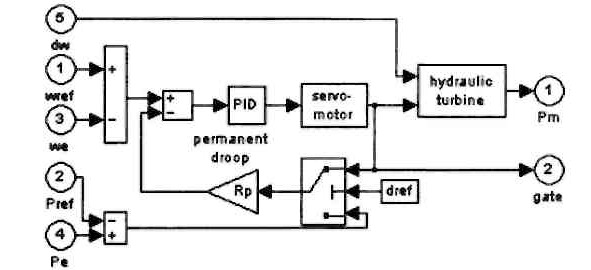
The required values of angular rotation speed (wref) and power (Pref) are fed to the first two inputs of the unit. The third and fourth inputs of the unit receive the actual values of the angular rotation speed (we) and active power (Pe). The fifth input is supplied with the deviation of the angular rotation frequency of the synchronous generator rotor (dw). The output signals are the mechanical power that must be supplied to the corresponding input of the synchronous machine unit (Rm), and the value of the hydraulic turbine gate opening (gate). Inputs 2 and 4 may remain unconnected if a signal about the shutter position is used as feedback, and not a speed deviation. Ice input and output values are measured in relative units.
The hydraulic turbine itself is modeled by a nonlinear system shown in Fig. 3.
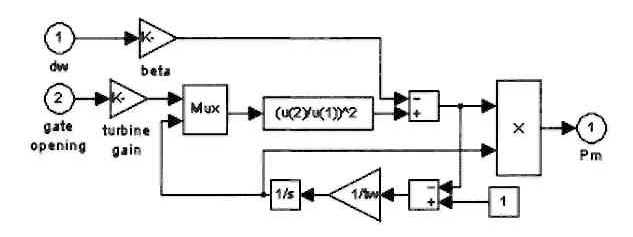
The servomotor controlling the turbine gate is modeled by a second-order system (Fig.4).
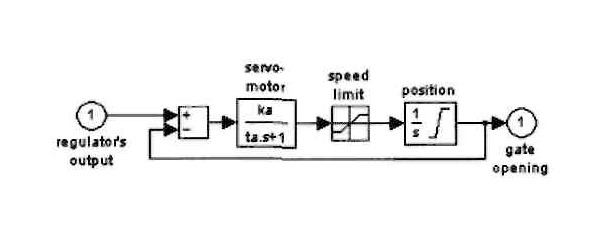
The window for setting parameters of the Hydraulic Turbine and Governor (HTG) block is shown in Fig.5.
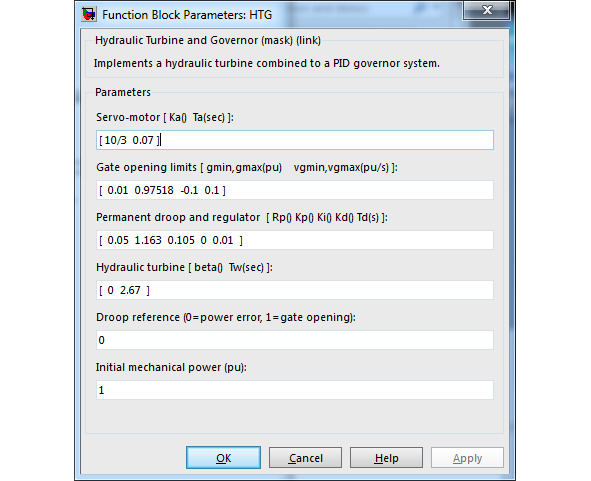
Unit parameters (HTG) :
Servo-motor [Ka () Ta (sec)]:
[Servo motor parameters] Parameters of the servo motor model: gain Ka and time constant Ta.
Gate opening limits [gmin, gmax (pu) vgmin, vgmax (pu/s)]:
[Gate control limits gmin, gmax (o.e.) vgmin, vgmax (o.e./c)]. The maximum and minimum values of the shutter coordinate are gmin, gmax (o.e.), as well as the maximum and minimum values of the shutter speed vgmin, vgmax (o.e./c).
Permanent droop and regulator [Rp () Kp () Ki () Kd () Td (s)]:
[Controller Parameters]. The transmission coefficient in the feedback circuit of the regulator Rp, the gain coefficients of the proportional (Kr) and integral (Ki) parts of the PID controller, the gain coefficient (Kd) of the real differentiating link of the PID controller and its time constant (Td).
Hydraulic turbine [beta () Tw (sec)]:
[Parameters of the hydraulic turbine beta () Tw (c)]. The damping coefficient of the deviation of the angular rotation speed beta and the time constant of the model of the hydraulic part of the turbine Tw (c).
Бесплатный фрагмент закончился.
Купите книгу, чтобы продолжить чтение.